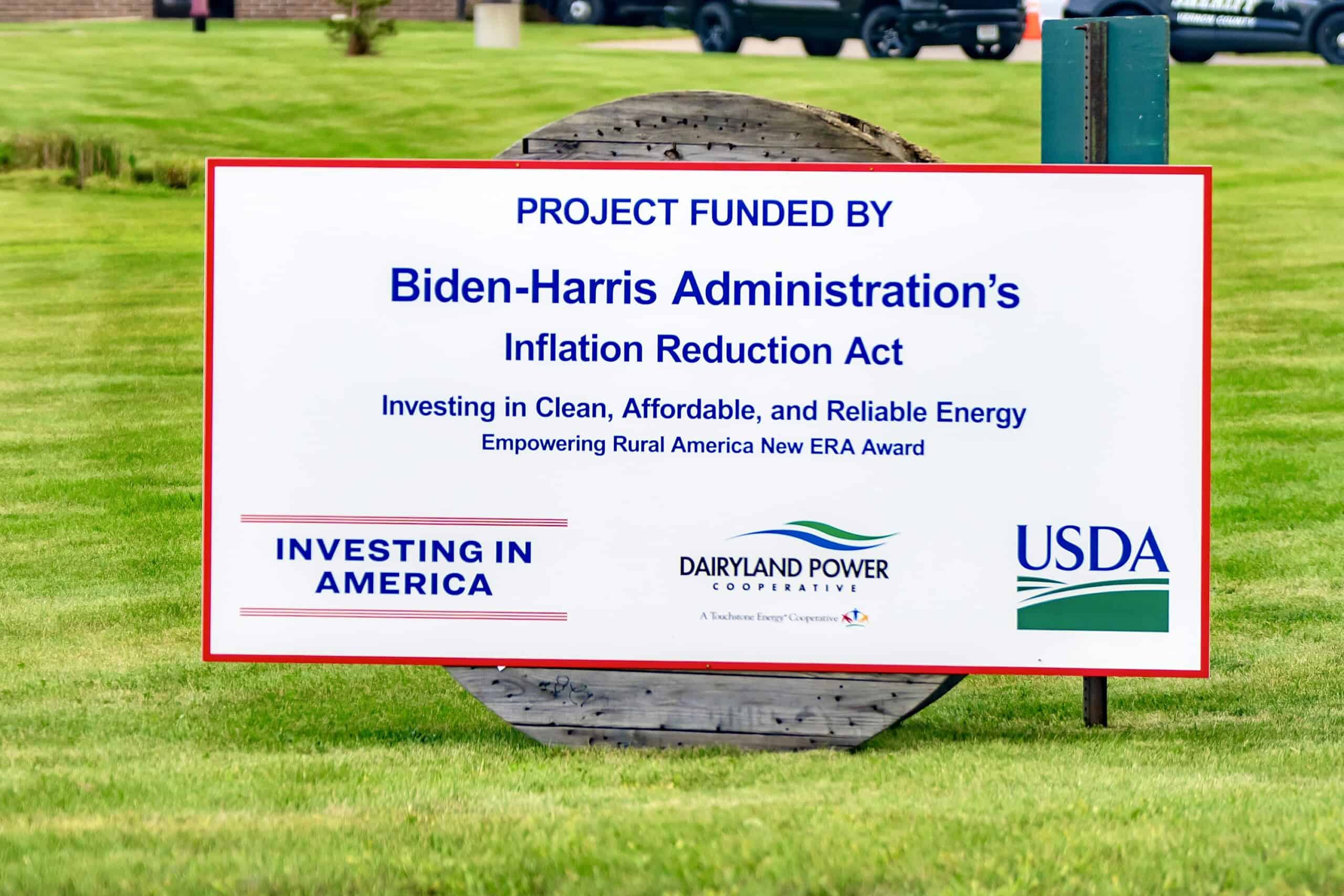
President Trump’s determination to undo his predecessor’s legacy has placed a huge question mark over billions of dollars worth of investments in clean energy and technology infrastructure begun under the Biden administration.
Donald Trump mentions ending the Green New Deal during his inaugural address, January 20, 2024. Credit: U.S. Department of State
Expect China to be central to the debate over what happens next.
In his inaugural speech on Monday, Trump took particular aim at the 2022 Inflation Reduction Act, one of President Biden’s signature pieces of legislation, pledging to “end the Green New Deal.” Later that day Trump signed an executive order ordering all agencies to “pause” the disbursement of funds from the IRA, pending a review.
Despite such actions, experts believe large parts of both the IRA and the 2022 CHIPS and Science Act — which unlocked billions of dollars to incentivize semiconductor and renewables manufacturing in the U.S. — could survive, in part because they support jobs and investment in both Republican and Democrat districts.
But most agree that the laws’ defenders will now have to place less emphasis on their role in combating the climate crisis, and more on their importance in challenging China’s dominance of key raw materials and supply chains.

“It’s not going to be framed as for renewables or for the energy transition,” says Arnab Datta, managing director for policy implementation at Employ America, a think tank. “But if you expand it to be about energy defense or building robust, resilient supply chains, these are programs with constituencies that Republicans care about too, whether it’s the mining industry, hawks who are worried about China, or farmers who want to access credits to install solar and wind. They address real problems where there’s consensus.”
In its final weeks, the Biden administration moved fast to preserve the impact of the CHIPS Act, its $52 billion bet on bringing advanced chip manufacturing back to the U.S. comprising grants, loans and tax credits.
…the Trump administration is still going to be responsible for monitoring the performance of all these grants, and withholding funding if they think milestones haven’t been met.
Jimmy Goodrich, a former semiconductor industry association executive and senior advisor to the RAND Corporation
Following Trump’s election victory last November, the CHIPS Program Office — which sits within the Commerce Department — raced to finalize loans and grants to several domestic and foreign companies. Taiwanese chipmaker TSMC is getting $6.6 billion in grants and up to $5 billion in loans to build a sprawling state-of-the-art semiconductor fab north of Phoenix, Arizona. Korea’s Samsung, meanwhile, will get up to $4.7 billion to build two fabs in Texas.

Since the enactment of the CHIPS Act, the program office has reached 34 deals across 22 states, awarding approximately $34 billion, according to figures from the Commerce Department, which it says will underpin planned investments worth nearly $450 billion — the largest wave of chip manufacturing expansion in U.S. history.
“It’s going to be hard to reverse a lot of these contracts signed with the government,” says Jimmy Goodrich, a former semiconductor industry association executive and senior advisor to the RAND Corporation. “But the Trump administration is still going to be responsible for monitoring the performance of all these grants, and withholding funding if they think milestones haven’t been met.”
The IRA faces a tougher battle: The Republican-led House of Representatives has already voted 53 times over the last four years to repeal parts of the law. Trump, in turn, has pledged to “end the electric vehicle mandate,” likely including the $7,500 consumer tax credit for electric vehicles that is one of its key features. The credit, known as 30D, has been instrumental in persuading automakers and their suppliers to procure materials from the U.S. or countries friendly to it, in order to meet strict sourcing requirements.

Still, the order Trump signed on Monday was equivocal on revoking the credit, ordering the government only to “consider” eliminating “unfair subsidies and other ill-conceived government-imposed market distortions that favor EVs over other technologies.” And Trump has been amenable to extending subsidies for renewables in the past — during his first term in office, the president quietly extended tax credits for wind and solar.
Other Republicans have focused on killing parts of the bureaucracy that administer the IRA’s funds. Project 2025, the Heritage Foundation’s policy blueprint for a second Trump term, has called for the elimination of the Department of Energy’s Loan Programs Office, which played a big role in doling out IRA funds to the EV and mining sectors under Biden.
Up to the final days of the Biden administration, the LPO rushed to get funding out of the door. It announced three loan guarantees on the Friday before Trump’s inauguration alone, including one for $15 billion to California’s main utility provider Pacific Gas & Electric Company to expand hydropower, battery energy storage and transmission, and close to $1 billion for Ioneer Rhyolite Ridge, a lithium miner. Under Biden, the office agreed to almost $50 billion in loans, and is still reviewing another 160 applications seeking over $200 billion more.
Key figures within the Trump administration are supportive of some technologies that have received backing from the IRA — including Chris Wright, a fracking executive who is Trump’s nominee for energy secretary.
“Wright has invested in next-gen technologies like [small modular reactors, a new type of nuclear reactor] and advanced geothermal,” says Datta of Employ America. “These are not industries that can succeed in the near to medium term without some level of government support.”

Some predict that Republicans will opt to lean on tax credits over loans or subsidies to incentivise advanced manufacturing, a tool that has proven popular even in Republican districts. One of the first things Congress will have to address is the 25 percent tax credit for investments in facilities making chips and chipmaking equipment, notes Goodrich, the advisor to RAND, as it expires in 2026.

“I expect there’ll be a congressional push to extend it and make it permanent,” he says.
In August, meanwhile, a group of 18 Republican lawmakers wrote to House Speaker Mike Johnson urging him to preserve energy tax credits from the IRA, crediting them for bringing clean energy jobs to their constituencies that make the U.S. “more energy independent and Americans more energy secure.”
The China threat could help defend offices like the LPO against attacks. The office released a roundup of its work on the last day of the Biden administration that heavily emphasized “geopolitical competition with China” and the need to catch up with its “scaled up government-subsidized manufacturing.”

Taking on China could also help justify other legislative initiatives that support the clean energy industry. In December, Rob Wittman (R-VA), a member of the House China select committee, introduced a bill that would establish a critical minerals reserve to help insulate western producers from price volatility caused by China’s dominance over metal supplies. Proponents view such a reserve as key to supporting the development in the U.S. of renewable energy and battery supply chains.
Framing such proposals in the language of taking on China could help proponents get the support they need to pass legislation — as well as allow Republicans to claim credit when new factories come online.
“There’s going to be a lot of ribbon cutting going on with all the construction,” says Sujai Shivakumar, an expert on innovation policy at the Center for Strategic and International Studies. “If [the Trump administration] were politically savvy, I’d imagined they’d be out there with their scissors.”

Eliot Chen is a Toronto-based staff writer at The Wire. Previously, he was a researcher at the Center for Strategic and International Studies’ Human Rights Initiative and MacroPolo. @eliotcxchen




